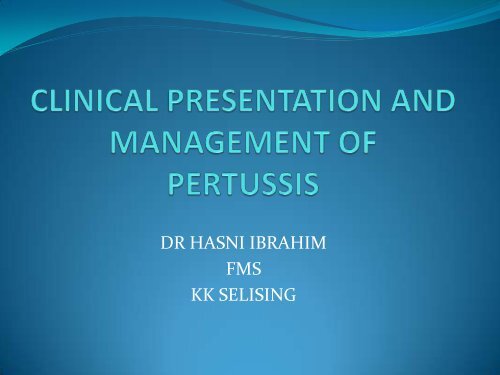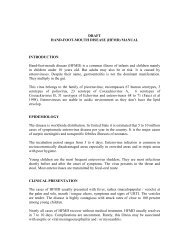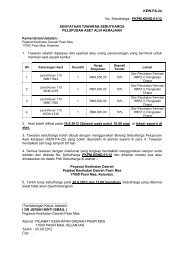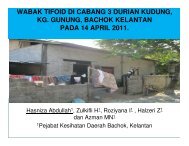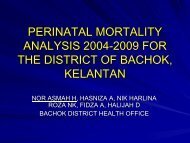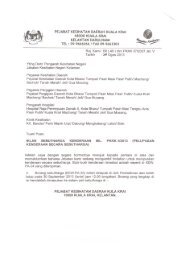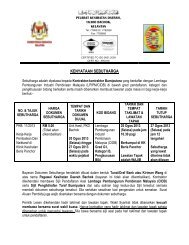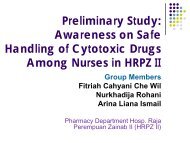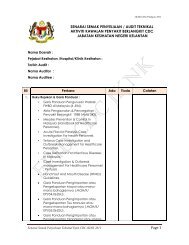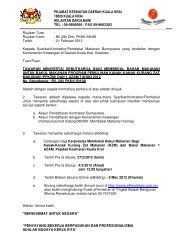CLINICAL PRESENTATION AND MANAGEMENT OF PERTUSSIS
CLINICAL PRESENTATION AND MANAGEMENT OF PERTUSSIS
CLINICAL PRESENTATION AND MANAGEMENT OF PERTUSSIS
You also want an ePaper? Increase the reach of your titles
YUMPU automatically turns print PDFs into web optimized ePapers that Google loves.
DR HASNI IBRAHIMFMSKK SELISING
Jadual ImunisasiIMUNISASI UMUR ( BULAN )0 1 2 3 4 5 6 12 18BCGHepatitis BDTaPHibPolioMeaslesMMRDos Primer Dos Tambahan Sabah sahaja
DTaP-IPV/Hib – KomposisiDifteriaHibVaksin kombinasi5 dalam 1TetanusPolio (IPV)Pertussis (aP)
OUTLINE• INTRODUCTION• <strong>CLINICAL</strong> <strong>PRESENTATION</strong>• COMPLICATION• LAB INVESTIGATION• TREATMENT <strong>AND</strong> PROPHYLAXIS• DISEASE SURVEILLANCE
<strong>PERTUSSIS</strong>• Respiratory infection caused by BordetellaPertussis• Highly contagious• Spread through1)respiratory droplets11) direct contacts with fluids fromnose or mouth of infected people• 100 day’s cough or cough of 100 days
• I.P of the disease is 5-10 days (max is up to 21 days)• The infectious period is at the beginning of catarrhalperiod which is prior to cough onset and up to 21 days afterthe cough started.• Antibiotics shorten the period of infectivity/lessen severity• Predominantly illness of infants under 2 years of age• Infant within the first week of life are susceptible, whenmortality from whooping cough is the highest• In adolescent & adult pertussis often present as chronicbronchitis.
<strong>CLINICAL</strong> <strong>PRESENTATION</strong>• Illness is characterised by 3 stagesa) catarrhal stageb) paroxysmalc) convalescent• Classic symptoms are paroxysmal cough, inspiratorywhoop and vomiting after coughing
• Catarrhal• Runny nose ( coryza)• Sneezing• Low grade fever ,malaise• Conjunctivalinflammation• Occasional cough,similarto common cold. Coughbecomes more severe butnon productive• Duration• Insidious• Gradually worseningsymptoms, lasted 1-2weeks
• Paroxysmal• Coughing spells withinspiratory whoop.• Whoop is absent under6/12 of age, teenage &adult.• Post tussive gagging/vomiting /cyanosis.• Convalescent• Gradual resolution ofsymptoms.• Duration• 2-4 weeks• Weight loss,leucocytosis, andlymphocytosis arecommon• Several weeks - months
Pertussive cough
Stages of pertussis inf and period ofcommunicabilityP---- P = period of communicabilitycough onset----P----l--------P-------------------------------2 -1 0 1 2 3 4 5 6 7 8 9 10 11 12(weeks of cough)/Catharral/ paroxysmal / convalescent /
complication• Asphyxia• Hypoxia• Encephalopathy• Convulsion• Cerebral hemorrhage• Pulmonary complication-atelectasis,pneumonia,pneumothorax• Death
Laboratory diagnosisDetection of B Pertussis- Culture, Polymerase chainreaction (PCR), direct immunofluorescence (DFA) andserological methodsCulture• special media – Regan Lowe charcoal agar media/Bordet –Gengou media• Gold standard• Sensitivity 15 - 80 %, specificity 100 %• Isolation during catarrhal stage is most succesful (first 1-2weeks of cough)• Culture requires 7-12 days• Affected by antibioticis
• Specimen collection and transportA) Pernasal swab or posterior nasopharynx specimenmust be obtained.Throat swab should not be taken.B) A dacron or calcium alginate (not cotton swab)on asoft flexible wire is passed through the nostrils and alongfloor of the nasal cavity into the posterior nasopharynx,rotate the swab and withdraw it, orlet it be there for 15 to30 sec or until a cough is producedC) Inoculate sample into special media and incubate for 7days
• PCR assay for B pertussisRecommended to detect B PertussisBetter than culture as it is not affected by antibioticSpecimen from health is sent to Sungai BulohSerial number (16) KKM – 171/BKP/09/43/0640)
Treatment and Prophylaxis• Tx reduces transmission• The spread can be limited by decrease infectivity andprotecting close contact.• Infectious starts from catarrhal stage thro third weekafter onset of paroxysms or until 5days after startingantibiotic• If begins in catarrhal stage , b4 paroxysmal coughlessenseverity.• If tx begins later it reduce period of infectivity not theseverity• Recommended doses for tx and chemoprophylaxis is thesame.
• Prophylaxis• Significant exposure to a confirmed case• In day care centre or school children• Check pattern of exposure/ exposure time• other coughing persons in the class• any other reported pertussis case• presence of high risk individuals• The need for prophylaxis in high risk group is imp• Infants• Non Immunized children• Immunocompromised individual• Pregnant women• Individuals with chronic respiratory illness,inc asthmatics
DRUGINFANTCHILDADULTERYTHROMYCIN
Disease SurveillanceCase Definition;Clinical case definition:• A person with a cough lasting at least two weeks withat least With one of the following:1. Paroxysms (i.e. fits) of coughing2. Inspiratory "whooping"3. Post-tussive vomiting (i.e. vomiting immediatelyafter fits of coughing)And without other apparent cause. ·
Case DefinitionLaboratory criteria for diagnosis• Isolation of Bordetella pertussis from clinicalspecimen,OR• Positive polymerase chain reaction (PCR) assay forB.pertussis.OR• Positive paired sera for B.pertussis.
Case Classification; Pertussis• Suspected: A case that meets the clinical case definition.• Confirmed:i. A clinical compatible case with B.pertussis isolation,ORii. A case that meet the clinical case definition and is confirmed by PCR, ORiii. A case that meet the clinical case definition and is confirmed serology testwith 4 fold rise of antibody in paired sera, ORiv. A case that meet the clinical case definition and is epidemiologically linkeddirectly to a confirmed case (first generation contact) by either culture orPCR.• In an outbreak settings with two or more cases epidemiologically linked, acase may be defined as a case with cough illness lasting more than 14 days.
Reporting & case Investigation1. Purpose of reporting & investigation2. Reporting & follow-upAny case of suspected pertussis must be notified to thenearest District Health Officewithin 7 days from the date of diagnosis3. Case Investigation4. Outbreak Mx5. Identify Contact
Purpose of reporting & investigationi. To investigate case, identify and evaluate contactsand recommend appropriate preventive measures,including exclusion, antibiotic prophylaxis and/orimmunization.ii. To assist in the diagnosis of cases.iii. To educate exposed persons regarding signs andsymptoms of the disease, thereby facilitating earlydiagnosis.iv. To identify situations of under vaccination orvaccine failure.
Reporting & Follow-up• Any case of suspected pertussis must be notified to thenearest District Health Officewithin 7 days from the date of diagnosis
Outbreak investigationDefinition of an outbreak• Two or more cases clustered in time (occurring within42 days of each other) and space (in one child carecenter / class). The outbreak case definition may beused to count cases if one case has been confirmed.• Investigate cases and their contacts as stated above.• Develop a line listing of the cases and their contactsfor easy reference.
Identify Contact• Identify close contacts that had significant exposure tothe case during the infectious period. “Close Contact “is defined as:- Direct face-face- Shared confined space; household,familymembers,classmate- Direct contact (medical staff)• Examine all high risk contact• Treat & give prophylaxis
Control of Patient & Contacts• IsolationSuspected cases not received antibiotics-isolated for3 weeks esp from young child & un-immunizedinfant.Isolation of contact:- symptomatic-3 week- asymptomatic h/care worker notreceiving a/b- ? 5 day- 3 week• Quarantine- excluded from school/daycare/public gatherings for3 weeks
Treatment & Prophylaxis• Tx- recommended antimicrobial agents• The need for prophylaxis in the following high riskgroups is particularly important:i. infantsii.non-immunized childreniii.immunocompromised individualsiv.pregnant womenv.individuals with chronic respiratory illness,including asthmatics
Control in Healthcare settings• Control measure should be Implemented when one ormore cases are recognized in hospital, institution,OPD or other health care setting• Apply the control measures to all patient,families & staff in close contact with confirm cases• Treat & given prophylaxis accordingly• HCW who used surgical mask during treating cases donot required prophylaxis.• Infectious control
Asses the immunization status ofclose contact under age 7• Contacts who are less than 7 years of age and are non-immunised orhave received fewer than 4 dose of DPT or DTaP should, in addition toreceiving antibiotic prophylaxis, have pertussis immunisation initiatedor continued according following guidelines, as soon as possible afterexposure :• Give 1 st dose at ≥ 6 weeks of age ; doses 1,2 and 3 must beseparated by at least 4 weeks• Children who receive their 3rd dose of DPT or DTaP ≥ 6 monthbefore exposure should receive the 4th dose at this time.• Children who have received four doses of DTP /DTaP shouldget a booster of DTP /DTaP, unless a dose has been givenwithin the last three years.
Preventive Measures• Educate the public, particularly parents of infants, aboutthe dangers of whooping cough and on the advantages ofinitiating immunization at 2 months of age and adheringto the immunization schedule.• Evaluate the immunization coverage of the locality. Domop-up if the coverage is less than 90%.• Active primary immunization against B. pertussis infectionis recommended with 3 doses of pertussis vaccineconsisting of a suspension of killed bacteria.• Routine childhood vaccination and post – exposureantimicrobial prophylaxis is the best preventive measuresagainst Pertussis.
THANK YOU FOR YOURATTENTION


